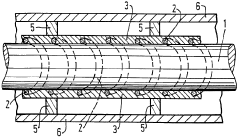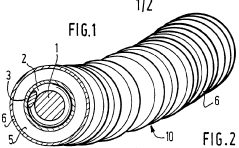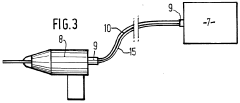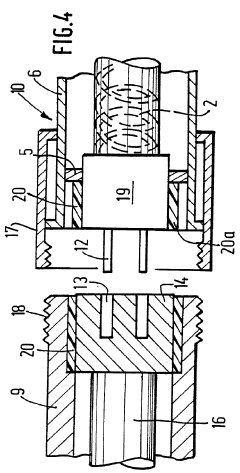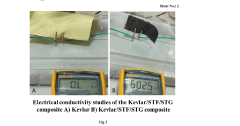Enhancing Kevlar’s Performance in Mechanical Load-Bearing Applications
JUL 10, 20259 MIN READ
Generate Your Research Report Instantly with AI Agent
Patsnap Eureka helps you evaluate technical feasibility & market potential.
Kevlar Enhancement Goals
Kevlar, a high-strength synthetic fiber developed by DuPont, has long been recognized for its exceptional mechanical properties. However, as the demands for advanced materials in load-bearing applications continue to grow, there is a pressing need to enhance Kevlar's performance further. The primary goal of Kevlar enhancement is to improve its mechanical properties while maintaining or reducing its weight, thereby expanding its applicability in various industries.
One of the key objectives is to increase Kevlar's tensile strength and modulus. Current research aims to achieve a tensile strength exceeding 4 GPa and a modulus of elasticity greater than 150 GPa. This improvement would significantly enhance Kevlar's load-bearing capacity, making it more suitable for applications in aerospace, automotive, and construction industries where high strength-to-weight ratios are crucial.
Another important goal is to enhance Kevlar's impact resistance and energy absorption capabilities. Researchers are working on developing Kevlar composites that can withstand higher impact energies without compromising structural integrity. The target is to achieve a 30% increase in impact resistance compared to current Kevlar formulations, which would greatly benefit protective gear and ballistic applications.
Improving Kevlar's resistance to environmental factors is also a critical objective. This includes enhancing its UV resistance, moisture resistance, and thermal stability. The aim is to develop Kevlar variants that can maintain their mechanical properties under harsh environmental conditions, with a particular focus on reducing property degradation by at least 50% when exposed to UV radiation and high humidity.
Researchers are also focusing on enhancing Kevlar's interfacial properties to improve its compatibility with various matrix materials in composite applications. The goal is to achieve a 40% increase in interfacial shear strength, which would lead to better load transfer between Kevlar fibers and the matrix, resulting in stronger and more durable composites.
Another significant enhancement target is to improve Kevlar's fatigue resistance. The aim is to develop Kevlar fibers that can withstand cyclic loading for extended periods without significant degradation in mechanical properties. The goal is to achieve a 25% increase in fatigue life compared to current Kevlar formulations, which would be particularly beneficial in applications involving repetitive stress, such as in aerospace and marine industries.
Lastly, there is a focus on enhancing Kevlar's processability and scalability. Researchers are working on developing new manufacturing techniques that allow for easier integration of Kevlar into complex structures and enable large-scale production of enhanced Kevlar materials. The goal is to reduce production costs by 20% while maintaining or improving the material's performance characteristics.
One of the key objectives is to increase Kevlar's tensile strength and modulus. Current research aims to achieve a tensile strength exceeding 4 GPa and a modulus of elasticity greater than 150 GPa. This improvement would significantly enhance Kevlar's load-bearing capacity, making it more suitable for applications in aerospace, automotive, and construction industries where high strength-to-weight ratios are crucial.
Another important goal is to enhance Kevlar's impact resistance and energy absorption capabilities. Researchers are working on developing Kevlar composites that can withstand higher impact energies without compromising structural integrity. The target is to achieve a 30% increase in impact resistance compared to current Kevlar formulations, which would greatly benefit protective gear and ballistic applications.
Improving Kevlar's resistance to environmental factors is also a critical objective. This includes enhancing its UV resistance, moisture resistance, and thermal stability. The aim is to develop Kevlar variants that can maintain their mechanical properties under harsh environmental conditions, with a particular focus on reducing property degradation by at least 50% when exposed to UV radiation and high humidity.
Researchers are also focusing on enhancing Kevlar's interfacial properties to improve its compatibility with various matrix materials in composite applications. The goal is to achieve a 40% increase in interfacial shear strength, which would lead to better load transfer between Kevlar fibers and the matrix, resulting in stronger and more durable composites.
Another significant enhancement target is to improve Kevlar's fatigue resistance. The aim is to develop Kevlar fibers that can withstand cyclic loading for extended periods without significant degradation in mechanical properties. The goal is to achieve a 25% increase in fatigue life compared to current Kevlar formulations, which would be particularly beneficial in applications involving repetitive stress, such as in aerospace and marine industries.
Lastly, there is a focus on enhancing Kevlar's processability and scalability. Researchers are working on developing new manufacturing techniques that allow for easier integration of Kevlar into complex structures and enable large-scale production of enhanced Kevlar materials. The goal is to reduce production costs by 20% while maintaining or improving the material's performance characteristics.
Market Demand Analysis
The market demand for enhanced Kevlar in mechanical load-bearing applications has been steadily growing across various industries. This demand is primarily driven by the increasing need for lightweight yet strong materials in sectors such as aerospace, automotive, and defense. The global market for high-performance fibers, including Kevlar, is projected to expand significantly in the coming years, with a particular focus on improved mechanical properties.
In the aerospace industry, there is a growing trend towards the use of advanced composites to reduce aircraft weight and improve fuel efficiency. Enhanced Kevlar, with its superior strength-to-weight ratio, is poised to play a crucial role in this sector. The automotive industry is also showing increased interest in high-performance materials like Kevlar for applications in structural components, impact-resistant panels, and tire reinforcement.
The defense sector remains a significant driver of demand for enhanced Kevlar. As military equipment evolves to meet modern warfare challenges, there is a constant need for materials that offer improved protection and durability while minimizing weight. This has led to ongoing research and development efforts to enhance Kevlar's performance in body armor, vehicle armor, and other protective gear.
In the industrial sector, the demand for high-strength, low-weight materials in applications such as pressure vessels, industrial belts, and ropes is also contributing to the market growth for enhanced Kevlar. The material's resistance to fatigue and its ability to maintain performance under extreme conditions make it particularly attractive for these applications.
The sports and recreation industry is another area where the demand for enhanced Kevlar is on the rise. From high-performance sporting equipment to protective gear, manufacturers are increasingly turning to advanced materials to improve product performance and durability.
Market analysis indicates that the Asia-Pacific region is expected to witness the highest growth rate in the demand for enhanced Kevlar and similar high-performance fibers. This is attributed to the rapid industrialization, increasing defense spending, and growing automotive and aerospace industries in countries like China and India.
Despite the positive market outlook, challenges such as high production costs and competition from alternative materials like carbon fiber and ultra-high-molecular-weight polyethylene (UHMWPE) fibers remain. However, ongoing research into cost-effective production methods and the development of hybrid materials incorporating Kevlar are expected to address these challenges and further drive market growth.
Overall, the market demand for enhanced Kevlar in mechanical load-bearing applications is robust and diverse, spanning multiple industries and geographical regions. The continuous push for lighter, stronger, and more durable materials across various sectors is likely to sustain and potentially accelerate this demand in the foreseeable future.
In the aerospace industry, there is a growing trend towards the use of advanced composites to reduce aircraft weight and improve fuel efficiency. Enhanced Kevlar, with its superior strength-to-weight ratio, is poised to play a crucial role in this sector. The automotive industry is also showing increased interest in high-performance materials like Kevlar for applications in structural components, impact-resistant panels, and tire reinforcement.
The defense sector remains a significant driver of demand for enhanced Kevlar. As military equipment evolves to meet modern warfare challenges, there is a constant need for materials that offer improved protection and durability while minimizing weight. This has led to ongoing research and development efforts to enhance Kevlar's performance in body armor, vehicle armor, and other protective gear.
In the industrial sector, the demand for high-strength, low-weight materials in applications such as pressure vessels, industrial belts, and ropes is also contributing to the market growth for enhanced Kevlar. The material's resistance to fatigue and its ability to maintain performance under extreme conditions make it particularly attractive for these applications.
The sports and recreation industry is another area where the demand for enhanced Kevlar is on the rise. From high-performance sporting equipment to protective gear, manufacturers are increasingly turning to advanced materials to improve product performance and durability.
Market analysis indicates that the Asia-Pacific region is expected to witness the highest growth rate in the demand for enhanced Kevlar and similar high-performance fibers. This is attributed to the rapid industrialization, increasing defense spending, and growing automotive and aerospace industries in countries like China and India.
Despite the positive market outlook, challenges such as high production costs and competition from alternative materials like carbon fiber and ultra-high-molecular-weight polyethylene (UHMWPE) fibers remain. However, ongoing research into cost-effective production methods and the development of hybrid materials incorporating Kevlar are expected to address these challenges and further drive market growth.
Overall, the market demand for enhanced Kevlar in mechanical load-bearing applications is robust and diverse, spanning multiple industries and geographical regions. The continuous push for lighter, stronger, and more durable materials across various sectors is likely to sustain and potentially accelerate this demand in the foreseeable future.
Current Limitations
Despite Kevlar's remarkable properties, it faces several limitations in mechanical load-bearing applications that hinder its full potential. One of the primary challenges is its relatively low compressive strength compared to its tensile strength. While Kevlar excels in tensile applications, it tends to buckle or kink under compressive loads, limiting its effectiveness in scenarios where both tensile and compressive forces are present.
Another significant limitation is Kevlar's susceptibility to environmental degradation. Exposure to ultraviolet (UV) light can cause photodegradation, leading to a reduction in mechanical properties over time. This vulnerability necessitates additional protective measures in outdoor applications, potentially increasing complexity and cost.
Moisture absorption is also a concern for Kevlar fibers. When exposed to humid environments, Kevlar can absorb moisture, which may lead to dimensional changes and potential degradation of mechanical properties. This hygroscopic nature can be particularly problematic in applications where dimensional stability is crucial.
The high cost of Kevlar production remains a limiting factor for its widespread adoption in certain industries. The complex manufacturing process and specialized equipment required contribute to its premium price point, making it less economically viable for some applications where cost-effectiveness is a primary consideration.
Kevlar's inherent stiffness, while beneficial in many scenarios, can pose challenges in applications requiring flexibility or conformability. This characteristic limits its use in situations where the material needs to adapt to complex geometries or undergo significant deformation without compromising its structural integrity.
Furthermore, Kevlar exhibits limitations in terms of its thermal properties. It has a relatively low melting point compared to some other high-performance fibers, which restricts its use in high-temperature environments. This thermal sensitivity can be a significant drawback in applications where exposure to elevated temperatures is expected.
The processing and fabrication of Kevlar can also present challenges. Its high strength and toughness make it difficult to cut and machine, requiring specialized tools and techniques. This complexity in processing can lead to increased manufacturing costs and potential limitations in design flexibility.
Lastly, while Kevlar offers excellent strength-to-weight ratios, there is an ongoing demand for even lighter materials with comparable or superior mechanical properties. This continuous push for improved performance drives the need for further enhancements or alternative materials that can surpass Kevlar's current capabilities in specific load-bearing applications.
Another significant limitation is Kevlar's susceptibility to environmental degradation. Exposure to ultraviolet (UV) light can cause photodegradation, leading to a reduction in mechanical properties over time. This vulnerability necessitates additional protective measures in outdoor applications, potentially increasing complexity and cost.
Moisture absorption is also a concern for Kevlar fibers. When exposed to humid environments, Kevlar can absorb moisture, which may lead to dimensional changes and potential degradation of mechanical properties. This hygroscopic nature can be particularly problematic in applications where dimensional stability is crucial.
The high cost of Kevlar production remains a limiting factor for its widespread adoption in certain industries. The complex manufacturing process and specialized equipment required contribute to its premium price point, making it less economically viable for some applications where cost-effectiveness is a primary consideration.
Kevlar's inherent stiffness, while beneficial in many scenarios, can pose challenges in applications requiring flexibility or conformability. This characteristic limits its use in situations where the material needs to adapt to complex geometries or undergo significant deformation without compromising its structural integrity.
Furthermore, Kevlar exhibits limitations in terms of its thermal properties. It has a relatively low melting point compared to some other high-performance fibers, which restricts its use in high-temperature environments. This thermal sensitivity can be a significant drawback in applications where exposure to elevated temperatures is expected.
The processing and fabrication of Kevlar can also present challenges. Its high strength and toughness make it difficult to cut and machine, requiring specialized tools and techniques. This complexity in processing can lead to increased manufacturing costs and potential limitations in design flexibility.
Lastly, while Kevlar offers excellent strength-to-weight ratios, there is an ongoing demand for even lighter materials with comparable or superior mechanical properties. This continuous push for improved performance drives the need for further enhancements or alternative materials that can surpass Kevlar's current capabilities in specific load-bearing applications.
Existing Solutions
01 Improved mechanical properties
Kevlar performance can be enhanced by improving its mechanical properties such as tensile strength, impact resistance, and durability. This can be achieved through various methods including fiber modification, composite formulation, and manufacturing techniques.- Improved mechanical properties: Kevlar performance can be enhanced by improving its mechanical properties such as tensile strength, impact resistance, and durability. This can be achieved through various methods including fiber modification, composite formulation, and manufacturing techniques.
- Heat and flame resistance: Kevlar's performance in high-temperature environments and flame-resistant applications can be improved. This involves developing treatments or modifications that enhance its thermal stability and fire-retardant properties while maintaining its structural integrity.
- Chemical resistance and stability: Enhancing Kevlar's resistance to various chemicals and improving its overall stability can expand its applications. This includes developing coatings or treatments that protect the fibers from degradation in harsh chemical environments.
- Lightweight and flexible designs: Improving Kevlar's performance in lightweight and flexible applications involves developing new manufacturing techniques or composite structures. This can lead to enhanced strength-to-weight ratios and improved flexibility without compromising protective properties.
- Integration with other materials: Kevlar's performance can be enhanced by integrating it with other materials to create hybrid composites. This approach combines the strengths of different materials to achieve superior overall performance in specific applications.
02 Heat and flame resistance
Kevlar's performance in high-temperature environments and flame-resistant applications can be improved. This involves developing treatments or modifications that enhance its thermal stability and fire-retardant properties without compromising other characteristics.Expand Specific Solutions03 Chemical resistance and stability
Enhancing Kevlar's resistance to various chemicals and improving its overall stability can expand its applications. This may involve surface treatments, coatings, or modifications to the polymer structure to increase its resistance to degradation in harsh chemical environments.Expand Specific Solutions04 Lightweight and flexible designs
Developing lighter and more flexible Kevlar-based materials while maintaining or improving strength and protective properties. This can involve creating new composite structures, optimizing fiber orientation, or incorporating other materials to enhance flexibility without sacrificing performance.Expand Specific Solutions05 Integration with smart technologies
Incorporating smart technologies into Kevlar-based materials to enhance their functionality. This can include embedding sensors, integrating with electronic systems, or developing responsive properties to improve performance in specific applications such as personal protective equipment or advanced composites.Expand Specific Solutions
Key Industry Players
The competition landscape for enhancing Kevlar's performance in mechanical load-bearing applications is characterized by a mature market with established players and ongoing research efforts. The global aramid fiber market, which includes Kevlar, is projected to reach $5.8 billion by 2026, indicating significant growth potential. Major companies like DuPont (Kevlar's inventor) and Teijin Limited dominate the market, while research institutions such as Fuzhou University, Southeast University, and Beijing Institute of Technology contribute to technological advancements. The technology's maturity is evident, with ongoing efforts focused on improving strength-to-weight ratios, impact resistance, and durability. Collaborations between industry leaders and academic institutions are driving innovation, aiming to expand Kevlar's applications in aerospace, automotive, and defense sectors.
Northrop Grumman Systems Corp.
Technical Solution: Northrop Grumman has developed an innovative approach to enhancing Kevlar's performance through a proprietary weaving technique. This method creates a three-dimensional Kevlar fabric structure that significantly improves load distribution and impact resistance[3]. The company has also explored incorporating shape memory alloys into Kevlar fabrics, allowing for adaptive load-bearing capabilities in response to environmental changes. Their research includes the development of nano-coatings that enhance Kevlar's resistance to UV degradation and chemical exposure, crucial for aerospace and military applications[4]. Furthermore, Northrop Grumman has invested in advanced computer modeling to optimize Kevlar composite designs for specific load-bearing scenarios.
Strengths: Strong integration with aerospace and defense industries, advanced manufacturing capabilities. Weaknesses: Solutions may be highly specialized and costly, potentially limiting broader commercial applications.
Government of the United States of America
Technical Solution: The U.S. government, through agencies like the Department of Defense and NASA, has been at the forefront of Kevlar research for enhancing its performance in mechanical load-bearing applications. They have developed a novel approach combining Kevlar with carbon nanotubes (CNTs) to create a hybrid material. This composite material exhibits significantly improved tensile strength and modulus compared to standard Kevlar[1]. The process involves dispersing CNTs within the Kevlar matrix, creating a more robust molecular structure. Additionally, they've explored surface treatments and coatings to enhance Kevlar's resistance to environmental degradation, potentially extending its lifespan in high-stress applications[2].
Strengths: Access to extensive research facilities and funding, ability to coordinate large-scale projects across multiple institutions. Weaknesses: Potential bureaucratic hurdles in implementing new technologies, longer timelines for commercialization.
Core Innovations
Device for the mechanical transmission of a rotation motion
PatentWO1986003266A1
Innovation
- A device utilizing a Kevlar spiral with an incompressible outer sheath and optionally multiple parallel spirals, along with a compression-hardening synthetic rubber sheath, to transmit rotational movement efficiently, reducing the risk of breakage and increasing flexibility and torque resistance without significant weight or diameter increase.
An improved process for fabricating kevlar fabric composite for multifunctional soft body armor
PatentPendingIN202321039845A
Innovation
- A composite material process involving Kevlar fabric impregnated with shear thickening fluid (STF) and shear-stiffening gel (STG), utilizing metal phosphate and carbon nanotubes, to enhance impact resistance, electrical conductivity, and flame retardancy, while allowing for temperature regulation.
Environmental Impact
The environmental impact of enhancing Kevlar's performance in mechanical load-bearing applications is a critical consideration in the development and implementation of advanced materials. Kevlar, a synthetic fiber known for its high strength-to-weight ratio, has been widely used in various industries, including aerospace, automotive, and personal protective equipment. As efforts to improve its mechanical properties continue, it is essential to assess the potential environmental consequences throughout its lifecycle.
The production of Kevlar involves energy-intensive processes and the use of chemical solvents, which can contribute to greenhouse gas emissions and potential environmental contamination if not properly managed. However, advancements in manufacturing techniques aimed at enhancing Kevlar's performance may also lead to more efficient production methods, potentially reducing overall energy consumption and waste generation. This balance between improved performance and environmental impact requires careful evaluation and optimization.
One of the key environmental benefits of enhancing Kevlar's performance is the potential for increased durability and longevity of products incorporating the material. Improved mechanical properties could lead to longer-lasting components in various applications, reducing the need for frequent replacements and ultimately decreasing waste generation. This extended product lifespan aligns with principles of sustainability and circular economy, potentially offsetting the initial environmental costs associated with production.
The use of enhanced Kevlar in lightweight structures, particularly in transportation applications, can contribute to improved fuel efficiency and reduced emissions. By enabling the design of lighter vehicles and aircraft without compromising safety, advanced Kevlar composites play a role in mitigating the environmental impact of the transportation sector. This indirect environmental benefit should be considered when assessing the overall ecological footprint of enhanced Kevlar materials.
End-of-life considerations for enhanced Kevlar products present both challenges and opportunities from an environmental perspective. While Kevlar is not biodegradable, research into recycling and repurposing techniques for high-performance fibers is ongoing. Developing effective recycling methods for enhanced Kevlar could significantly reduce its environmental impact, closing the loop in its lifecycle and minimizing waste sent to landfills.
The potential for enhanced Kevlar to replace less environmentally friendly materials in certain applications should also be evaluated. If improvements in mechanical properties allow Kevlar to substitute materials with higher environmental impacts, such as certain metals or energy-intensive composites, the net environmental benefit could be substantial. This substitution effect highlights the importance of considering the broader system-level impacts when assessing the environmental implications of material enhancements.
The production of Kevlar involves energy-intensive processes and the use of chemical solvents, which can contribute to greenhouse gas emissions and potential environmental contamination if not properly managed. However, advancements in manufacturing techniques aimed at enhancing Kevlar's performance may also lead to more efficient production methods, potentially reducing overall energy consumption and waste generation. This balance between improved performance and environmental impact requires careful evaluation and optimization.
One of the key environmental benefits of enhancing Kevlar's performance is the potential for increased durability and longevity of products incorporating the material. Improved mechanical properties could lead to longer-lasting components in various applications, reducing the need for frequent replacements and ultimately decreasing waste generation. This extended product lifespan aligns with principles of sustainability and circular economy, potentially offsetting the initial environmental costs associated with production.
The use of enhanced Kevlar in lightweight structures, particularly in transportation applications, can contribute to improved fuel efficiency and reduced emissions. By enabling the design of lighter vehicles and aircraft without compromising safety, advanced Kevlar composites play a role in mitigating the environmental impact of the transportation sector. This indirect environmental benefit should be considered when assessing the overall ecological footprint of enhanced Kevlar materials.
End-of-life considerations for enhanced Kevlar products present both challenges and opportunities from an environmental perspective. While Kevlar is not biodegradable, research into recycling and repurposing techniques for high-performance fibers is ongoing. Developing effective recycling methods for enhanced Kevlar could significantly reduce its environmental impact, closing the loop in its lifecycle and minimizing waste sent to landfills.
The potential for enhanced Kevlar to replace less environmentally friendly materials in certain applications should also be evaluated. If improvements in mechanical properties allow Kevlar to substitute materials with higher environmental impacts, such as certain metals or energy-intensive composites, the net environmental benefit could be substantial. This substitution effect highlights the importance of considering the broader system-level impacts when assessing the environmental implications of material enhancements.
Manufacturing Challenges
The manufacturing of Kevlar for enhanced performance in mechanical load-bearing applications presents several significant challenges. One of the primary obstacles is achieving consistent fiber quality across large production volumes. The molecular alignment of Kevlar fibers is crucial for their strength, and any inconsistencies in the spinning process can lead to variations in fiber properties. This requires precise control over temperature, pressure, and extrusion rates during production.
Another challenge lies in the development of advanced spinning techniques to produce fibers with improved mechanical properties. Traditional wet-spinning methods may not be sufficient to achieve the desired enhancements in strength and stiffness. Researchers are exploring novel approaches such as gel-spinning and electrospinning to create fibers with higher molecular orientation and fewer defects.
The incorporation of nanoparticles or other reinforcing agents into Kevlar fibers presents additional manufacturing hurdles. Achieving uniform dispersion of these additives throughout the polymer matrix is critical for optimal performance enhancement. This often requires the development of new mixing and processing techniques that can maintain the integrity of the Kevlar structure while effectively integrating the reinforcing materials.
Post-processing treatments, such as heat treatment or chemical modification, also pose challenges in the manufacturing process. These treatments aim to further improve the mechanical properties of Kevlar fibers, but they must be carefully controlled to avoid degradation of the polymer structure. Balancing the benefits of these treatments with the potential risks to fiber integrity requires extensive research and optimization.
Scaling up production while maintaining quality is another significant manufacturing challenge. As demand for high-performance Kevlar increases, manufacturers must develop processes that can produce large quantities of enhanced fibers without compromising their properties. This often involves redesigning production equipment and implementing advanced quality control measures throughout the manufacturing line.
Environmental considerations also play a role in the manufacturing challenges. The production of Kevlar involves the use of strong acids and organic solvents, which can have environmental impacts. Developing more sustainable manufacturing processes that reduce the use of harmful chemicals or implement effective recycling systems is an ongoing challenge in the industry.
Another challenge lies in the development of advanced spinning techniques to produce fibers with improved mechanical properties. Traditional wet-spinning methods may not be sufficient to achieve the desired enhancements in strength and stiffness. Researchers are exploring novel approaches such as gel-spinning and electrospinning to create fibers with higher molecular orientation and fewer defects.
The incorporation of nanoparticles or other reinforcing agents into Kevlar fibers presents additional manufacturing hurdles. Achieving uniform dispersion of these additives throughout the polymer matrix is critical for optimal performance enhancement. This often requires the development of new mixing and processing techniques that can maintain the integrity of the Kevlar structure while effectively integrating the reinforcing materials.
Post-processing treatments, such as heat treatment or chemical modification, also pose challenges in the manufacturing process. These treatments aim to further improve the mechanical properties of Kevlar fibers, but they must be carefully controlled to avoid degradation of the polymer structure. Balancing the benefits of these treatments with the potential risks to fiber integrity requires extensive research and optimization.
Scaling up production while maintaining quality is another significant manufacturing challenge. As demand for high-performance Kevlar increases, manufacturers must develop processes that can produce large quantities of enhanced fibers without compromising their properties. This often involves redesigning production equipment and implementing advanced quality control measures throughout the manufacturing line.
Environmental considerations also play a role in the manufacturing challenges. The production of Kevlar involves the use of strong acids and organic solvents, which can have environmental impacts. Developing more sustainable manufacturing processes that reduce the use of harmful chemicals or implement effective recycling systems is an ongoing challenge in the industry.
Unlock deeper insights with Patsnap Eureka Quick Research — get a full tech report to explore trends and direct your research. Try now!
Generate Your Research Report Instantly with AI Agent
Supercharge your innovation with Patsnap Eureka AI Agent Platform!
